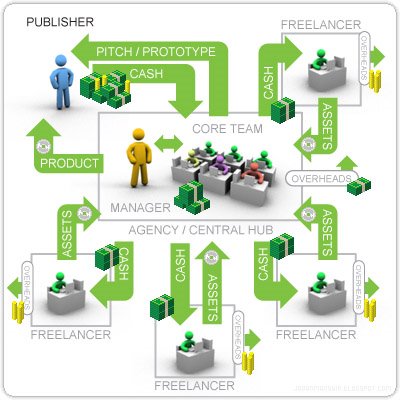There were many reasons why I left 'conventional' (i.e. cubical) employment to work on Vox Pop Design full time. One of those was a need to explore alternative ways of organizing creative talent. In studying how other creative functional groups are organized I came across what many refer to as the Hollywood Model.
Note: The pictures for this piece come from the Japanmanship blog. In that piece he describes using the Hollywood model to change the games industry. The diagrams are also extremely relevant for web design — just replace the 'publisher' shown in the images with 'customer'.

In traditional custom software development a customer approaches a firm for a project. The first meetings may be with a sales rep or (in smaller cases) with project leads to clarify scope and come up with requirements. These then filter down until the developers 'in the trenches' receive their marching orders. Change requests are carried from the top of the chain to the bottom and questions are bubbled from the bottom to the top. Like the game 'telephone' these messages often become altered with the number of re-tellings between individuals, leading to more requests and more questions. While all this is going on overhead expenses — office space, benefits, company branded trinkets from HR, etc — continue to accrue. Wages for untapped labor — say a database guy in one of those cubicals who is on the sidelines during a front end redesign — also begin to add up. The software firm needs them when projects require it. However, not all projects do. In those cases management further has their hands full finding busy work — something that adds additional organizational overhead and does not serve the customer.
Now studios have large structures with their logos on them. They have permanently staffed marketing, sales, and accounting divisions. When I refer to the Hollywood model I'm not referring to a Universal or Paramount. Instead I'm referring to the organizational make up of the creative teams behind the movies that we enjoy. These would be the directors, cinematographers, costume designers, etc. These creative types aren't staffed by one shop in side by side cubicals. The teams are extremely ad-hoc; they come together because their talents are uniquely suited for a project, they do their jobs, they have the wrap party, and then are off to their next thing.

That brings us to the second diagram, this time of a firm structured to the 'Hollywood Model' way of organization. It still has an agency at the center. This firm, like Vox Pop, serves several purposes:
- Provides a consistent point of contact.
- Serves as project oversight assigning tasks, integrating work, and ensuring quality.
- Evaluates talent and determines compatibility.
- Acts as unifying 'public face' for free agents.
In Utah I've been blessed to be surrounded with a number of highly skilled people. While many of them have traditional 9-5 employment they are also looking for opportunities on the side. This model allows them to contribute their considerable talents to fulfilling projects as they are able. It provides a variety of work that they might not get during their day employment. And the customer gets an extremely high quality product because we're not using just whoever has some free man-months at the moment. We seek out the best experts available to contribute solely for their project. Overhead is low. And I never invite you to tedious company 'socials' and expect you to make small talk.
Are there problems with this way of organization? Absolutely. For one, I spend a considerable amount of time 'talent scouting'. The freedom that is given to freelancers means that they may not have the time to the degree that you need it when you need it. That leads to my second point: the central agency (in this case, myself) needs to be incredibly diligent in planning with the flexibility to adapt at the drop of a hat (although I still believe that overhead to be lower of that than the brick n' mortar firm). Third, and one of the things that keeps me up at night, is the lack of assets or equity this model creates. If I was to decide to move back to South Dakota today there would be nothing to sell. Fourth, a firm organized in this way is NOT ideal for any work that requires a degree of security (government, military, health care, etc). This is because the freelancers are using their own equipment in their own spaces and communicating back over (likely) unsecured channels. Fifth is the lack of any kind of health care benefits for for freelancers. Many 'agents' that I've worked with yearn for the freedom of freelancing but are tethered to a beige prison because they cannot afford health care at the same level they've previously enjoyed. It's not just a problem that I face. However, if this model has any shot at scaling there needs to be some form of affordable coverage available to allow the best and brightest to pursue projects at their leisure.
There is considerably more and this brief overview is a gross oversimplification of the economics, sociology, and theory behind what's happening. However, the initial experiment has been going very well. I think there is something here that is worth continued exploration.
Originally published on the Vox Pop Design Blog, May 22nd, 2007.




